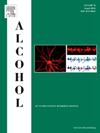Impact of plastic sipper devices on alcohol self-administration in rodents: Limitations for long-term access paradigms
IF 2.9
4区 医学
Q3 PHARMACOLOGY & PHARMACY
引用次数: 0
Abstract
Open source devices are becoming widely used in behavioral neuroscience. Despite their advantages in cost effectiveness, modularity, and customization, measurements obtained using newly developed devices may not always recapitulate measurements from existing and validated equipment, potentially due to the materials used in manufacture. In this study, we evaluated a commonly used open-source optical lickometer that delivers fluid via a Hydropac® plastic valve in a multi-site intermittent access two-bottle choice (IA2BC) paradigm for alcohol consumption. Mice were tested with both traditional metal sippers and plastic sippers equipped with Hydropac® valves to assess differences in alcohol intake, preference, and total fluid consumption. Our findings revealed that mice displayed reduced intake and preference for alcohol (10–20% v/v) delivered via the Hydropac® containing plastic sippers. Notably, the effect was observed at both testing sites, suggesting a generalizable phenomenon. The decreased intake was also specific to alcohol, as water, quinine, and sucrose consumption were unaffected by sipper type. To investigate the underlying cause of the reduced alcohol consumption, we pre-incubated Hydropac® valves in 20% alcohol and found that the pre-treated alcohol reduced intake even when delivered via metal sippers. This suggests that prolonged interaction between alcohol and the components of the Hydropac® valves alter the fluid, likely by generating unpalatable contaminants. These results highlight a limitation of using plastic sippers in long-term alcohol self-administration studies. While these devices may remain suitable for limited access paradigms their use in extended access protocols may compromise data integrity. Our study underscores the need for rigorous validation of open-source hardware in each research project.
塑料吸管装置对啮齿动物酒精自我管理的影响:长期获取范式的局限性。
开源设备在行为神经科学领域的应用越来越广泛。尽管它们在成本效益、模块化和定制方面具有优势,但使用新开发的设备获得的测量结果可能并不总是概括现有和经过验证的设备的测量结果,这可能是由于制造过程中使用的材料。在这项研究中,我们评估了一种常用的开源光学液滴计,该液滴计通过Hydropac®塑料阀在多站点间歇访问双瓶选择(IA2BC)范式中提供液体。小鼠分别用传统的金属吸管和装有Hydropac®阀门的塑料吸管进行测试,以评估酒精摄入量、偏好和总液体消耗量的差异。我们的研究结果显示,小鼠对通过含有塑料吸管的Hydropac®提供的酒精(10-20% v/v)的摄入量减少和偏好。值得注意的是,在两个测试地点都观察到这种影响,这表明了一种可推广的现象。饮酒量的减少也与酒精有关,而水、奎宁和蔗糖的摄入量不受饮酒者类型的影响。为了调查酒精消耗量减少的根本原因,我们将Hydropac®阀门在20%的酒精中预孵化,发现即使通过金属吸管输送,预处理后的酒精也会减少摄入量。这表明,酒精与Hydropac®阀门成分之间的长期相互作用可能会产生令人难以接受的污染物,从而改变流体。这些结果强调了在长期酒精自我管理研究中使用塑料吸管的局限性。虽然这些设备可能仍然适用于有限的访问范例,但在扩展访问协议中使用它们可能会损害数据完整性。我们的研究强调了在每个研究项目中对开源硬件进行严格验证的必要性。
本文章由计算机程序翻译,如有差异,请以英文原文为准。
求助全文
约1分钟内获得全文
求助全文
来源期刊

Alcohol
医学-毒理学
CiteScore
4.60
自引率
4.30%
发文量
74
审稿时长
15.6 weeks
期刊介绍:
Alcohol is an international, peer-reviewed journal that is devoted to publishing multi-disciplinary biomedical research on all aspects of the actions or effects of alcohol on the nervous system or on other organ systems. Emphasis is given to studies into the causes and consequences of alcohol abuse and alcoholism, and biomedical aspects of diagnosis, etiology, treatment or prevention of alcohol-related health effects.
Intended for both research scientists and practicing clinicians, the journal publishes original research on the neurobiological, neurobehavioral, and pathophysiological processes associated with alcohol drinking, alcohol abuse, alcohol-seeking behavior, tolerance, dependence, withdrawal, protracted abstinence, and relapse. In addition, the journal reports studies on the effects alcohol on brain mechanisms of neuroplasticity over the life span, biological factors associated with adolescent alcohol abuse, pharmacotherapeutic strategies in the treatment of alcoholism, biological and biochemical markers of alcohol abuse and alcoholism, pathological effects of uncontrolled drinking, biomedical and molecular factors in the effects on liver, immune system, and other organ systems, and biomedical aspects of fetal alcohol spectrum disorder including mechanisms of damage, diagnosis and early detection, treatment, and prevention. Articles are published from all levels of biomedical inquiry, including the following: molecular and cellular studies of alcohol''s actions in vitro and in vivo; animal model studies of genetic, pharmacological, behavioral, developmental or pathophysiological aspects of alcohol; human studies of genetic, behavioral, cognitive, neuroimaging, or pathological aspects of alcohol drinking; clinical studies of diagnosis (including dual diagnosis), treatment, prevention, and epidemiology. The journal will publish 9 issues per year; the accepted abbreviation for Alcohol for bibliographic citation is Alcohol.
 求助内容:
求助内容: 应助结果提醒方式:
应助结果提醒方式:


